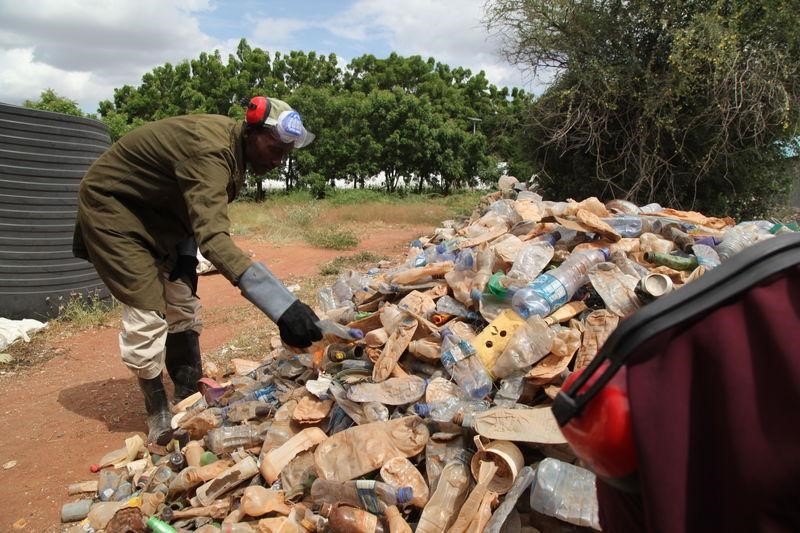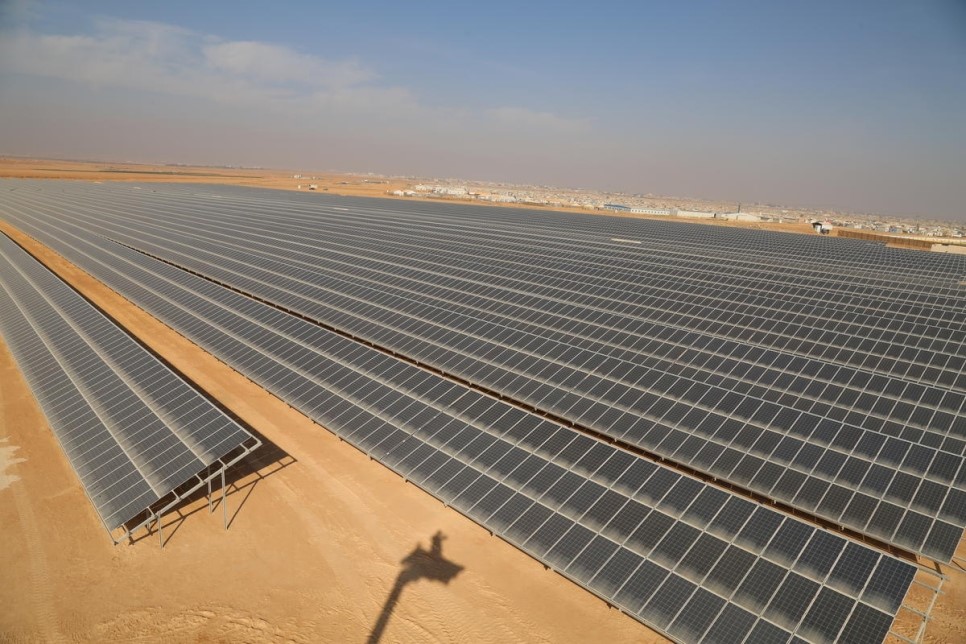Jordan’s Za’atari refugee camp solar power plant (Credit: UNHCR/Yousef Al Hariri).
2020 was predicted to be a major year for undertaking action to mitigate the effects of the climate crisis. Following momentum generated by initiatives including the school climate strikes and the impassioned words of figures such as Greta Thunberg, there was a new level of hope and urgency, and anticipation for impending international talks. However, the COVID-19 pandemic has led to the postponement of such events,and diverted both attention and resources from the issue.
Prior to the pandemic, this anticipation for change was also apparent in the humanitarian sector. Yet, the humanitarian and environmental sectors have predominantly been considered separate. Due to the capacity of aid organisations often being highly stretched, environmental considerations are often side-lined, as necessities such as providing adequate food and shelter take precedence. However, there is rapidly growing recognition that humanitarian organisations need to reduce the environmental impacts of their operations.
Environmental impacts of humanitarian work
Humanitarian action encompasses an incredible range of activities, many of which have adverse environmental impacts. A key environmental concern of humanitarian work derives from energy use, particularly carbon-emitting fossil fuels. Energy is crucial to humanitarian work, and in many cases it is vital that fuel can be easily and quickly deployed. Many refugee camps are in remote locations, meaning humanitarian agencies consume considerable amounts of fuel transporting staff, equipment and supplies, whilst operations are often dependent on on-site electricity generation to power essential facilities. Diesel is extensively used due to these reasons, which results in significant carbon emissions.
Another concern associated with humanitarian work is waste generated from materials used to package items such as food and pharmaceutical supplies. Strong packaging, often plastic, is required for such items, as they have to travel long distances and withstand varying temperatures. However, after products are unbundled, packaging materials can become waste immediately, often accumulating in local environments, particularly in locations with insufficient local waste management systems.
There is increasing recognition of how humanitarian operations can lead to environmental degradation. This is exemplified by the impact of the establishment and expansion of refugee camps in Cox’s Bazar, Bangladesh, which has led to environmental degradation both within refugee settlements and the surrounding region. The expansion of existing camps and construction of new facilities has led to more than 2000 ha of forest loss in the Cox’s Bazar region, and has blocked the migration route of the endangered Asian elephant. This land-use change has increased the risk of landslides in the region, and has caused tension with local communities who depend on the forests.
Plastic waste at the recycling plant in the Dabaab refugee camp (Credit: Thomson Reuters Foundation/Nita Bhalla).
Action being taken
In response, there have been a multitude of actions and initiatives undertaken, as well as increased efforts to bridge the gap between humanitarian and environmental actors. This is particularly demonstrated by the Environmental and Humanitarian Actors Network (EHA), established to enable the sharing of guidelines and practices to mitigate the environmental impact of humanitarian operations.
With the expansion of such resources, some humanitarian organisations have made efforts to reduce their overall environmental impact. The Red Cross, for example, has made significant efforts to do this through activities such as increasing renewable energy use, and cutting its travel budget in favour of expanding video conference facilities.
Aid agencies are also devising innovative solutions to reduce waste and increase recycling. Organisations responsible for delivering food, such as the WFP, have developed methods to preserve their products, whilst simultaneously reducing waste and bringing down transport costs. Humanitarian organisations are also collaborating with refugees to tackle plastic waste generated at refugee camps. For example, the Kenya Red Cross Society has established a recycling project at the Dadaab refugee camp in Kenya, with the aim to recycle plastic waste generated at the camp, whilst also providing refugees with a source of income.
A significant way for aid agencies to reduce the environmental impact of their operations is through the use of renewable energy, which can lead to major reductions in carbon emissions, as well as substantial financial savings. Forms of renewable energy are already being used in refugee camps in Jordan for example, as in the Zaatari and Azraq camps, solar panels are being used to provide a sustainable source of energy to power shelters and food stores for tens of thousands of Syrian refugees living in the camps.
Final thoughts
Humanitarian organisations undertake vital work, often in extreme circumstances. Consequently, environmental considerations are often given less precedence than other essential needs. However, as the impacts human activities are having on the environment are becoming even more evident, the need for humanitarian organisations to reduce the environmental impact of their operations is becoming increasingly apparent. Although several organisations are making incredible, innovative steps to do this, there is a significant need for others to follow. Not only can these measures improve levels of environmental sustainability, they can also lead to social and economic benefits.
At MOAS we are doing our best to be more sustainable wherever possible. In Bangladesh, in response to COVID-19 we are making reusable masks to prevent the waste associated with single-use masks and we procure all the material for the project locally to avoid the emissions linked with importing from abroad. MOAS’ office also uses solar energy and we have been replacing in-person events with online events wherever possible to further reduce our impact on the environment.
If you are interested in the work of MOAS and our partners, please follow us on social media, sign up to our newsletter and share our content. You can also reach out to us any time via [email protected]. If you want to support our operations, please give what you can at www.moas.eu/donate.



